Encapsulating Ru Nanoclusters for Reductive Imination of Biomass-Based Furfural by Shape-Selective Catalysis
IF 11.3
1区 化学
Q1 CHEMISTRY, PHYSICAL
引用次数: 0
Abstract
Reductive imination of aldehydes to the corresponding secondary imines, while attractive and promising, remains a big challenge due to consecutive hydrogenation and hydroammonolysis of the in situ formed imine. Herein, we describe a strategy of shape-selective catalysis for the reductive imination of biomass-derived furfural with H2NOH and H2 by using Ru nanoclusters confined within the regular micropores of ZSM-5 (Ru@ZSM-5). The Ru@ZSM-5 features a consecutive furfural oxime-hydrogenation and furfurylimine-hydrogenation due to their closed molecular sizes to the pore apertures (5.3 × 5.6 Å) of the ZSM-5. In contrast, the in situ formed secondary imine (4.3 × 11.2 Å) with a large molecular size could not pass through ZSM-5 micropores to reach the active Ru sites, thus remaining unaffected without further hydrogenation and hydroammonolysis. The shape-selectivity of Ru@ZSM-5 is further confirmed by catalyst-passivation and hydrogen-spillover experiments. The Ru@ZSM-5 shows high activity and shape-selectivity with good recyclability and is easily extended to reductive imination of a variety of aldehydes.

封装 Ru 纳米团簇通过形状选择催化还原碘化生物质糠醛
将醛还原还原为相应的仲亚胺虽然具有吸引力和前景,但由于原位生成的亚胺需要连续加氢和氢氨解,因此仍然是一个很大的挑战。在此,我们描述了一种形状选择性催化策略,通过限制在ZSM-5的规则微孔内的Ru纳米团簇,用H2NOH和H2还原模拟生物质衍生的糠醛(Ru@ZSM-5)。由于分子尺寸与ZSM-5的孔径(5.3 × 5.6 Å)接近,Ru@ZSM-5具有连续的糠醛肟加氢和糠醛胺加氢。而原位形成的大分子亚胺(4.3 × 11.2 Å)则无法通过ZSM-5微孔到达活性Ru位点,因此不受进一步加氢和氢氨解的影响。通过催化剂钝化和氢溢出实验进一步证实了Ru@ZSM-5的形状选择性。Ru@ZSM-5具有较高的活性和形状选择性,具有良好的可回收性,易于扩展到多种醛的还原模拟。
本文章由计算机程序翻译,如有差异,请以英文原文为准。
求助全文
约1分钟内获得全文
求助全文
来源期刊

ACS Catalysis
CHEMISTRY, PHYSICAL-
CiteScore
20.80
自引率
6.20%
发文量
1253
审稿时长
1.5 months
期刊介绍:
ACS Catalysis is an esteemed journal that publishes original research in the fields of heterogeneous catalysis, molecular catalysis, and biocatalysis. It offers broad coverage across diverse areas such as life sciences, organometallics and synthesis, photochemistry and electrochemistry, drug discovery and synthesis, materials science, environmental protection, polymer discovery and synthesis, and energy and fuels.
The scope of the journal is to showcase innovative work in various aspects of catalysis. This includes new reactions and novel synthetic approaches utilizing known catalysts, the discovery or modification of new catalysts, elucidation of catalytic mechanisms through cutting-edge investigations, practical enhancements of existing processes, as well as conceptual advances in the field. Contributions to ACS Catalysis can encompass both experimental and theoretical research focused on catalytic molecules, macromolecules, and materials that exhibit catalytic turnover.
 求助内容:
求助内容: 应助结果提醒方式:
应助结果提醒方式:


